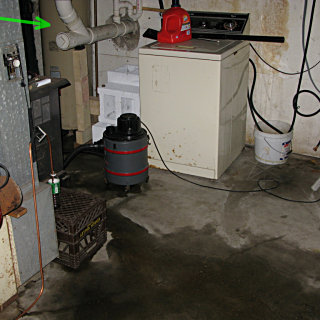
The brilliant white cinderblocks are explained in another document.
Discovery
|
In the middle of February '08 I discovered the hard way that it was time for
a new water heater. Actually I got pretty lucky and there were only a few
large puddles sluggishly creeping across the basement floor by the time I
found out, rather than the several feet of water and significant collateral
damage that it could have been. It could have been leaking for hours or days,
I have no idea since I don't go down there all that frequently.
Anyway, this radically altered my priorities for that evening and I began triaging. After shutting off the cold supply to the heater [fortunately the valve, under its centuries of green encrustation, still appeared to work and didn't crumble in my hands], I worked on slurping up the water with the wet-vac and dumping it outside the basement bulkhead. Then came the problem of emptying the heater so its remaining contents wouldn't also leak out, assuming the leak was near the bottom. The drain stopcock was all of an inch above floor level, which does no good in a basement with window-level grade all the way around the house and no sump well. Those common diagrams showing how to blow down a water heater into a "nearby convenient drain" were all for naught here. However, the wet-vac hose fit very nicely over the stopcock outlet and I was able to drain the heater by sucking out a dozen or so vac-tank-loads of water and dumping them outside too. It took a while and was very noisy, but at least now I knew that the leakage was stopped. After things felt like they were under some semblance of control did I think about grabbing any pictures, because something told me this was the start of a somewhat involved project. I thought it rather ironic that water heaters had just recently been a subject on a local homeowners' mailing list that I'm on, with a couple of other people asking for recommendations on, uh, very short notice. |

|
This was the scene after about two frantic hours of work with the wet-vac, but
the floor was actually beginning to dry up. Yay for the arid air generally
found inside a house in the winter! The offending appliance is back there
[green arrow], behind the PVC septic pipe. To shut down the entire hot side
of the system I also had to turn off the kitchen sink hot supply, since
otherwise cold water could easily crossfeed back into the hot pipe through the
single-handle mixing valve even if it was kicked all the way over to cold.
It's not that precise by any means, and I didn't want anything collecting back
into the heater tank.
The brilliant white cinderblocks are explained in another document. |
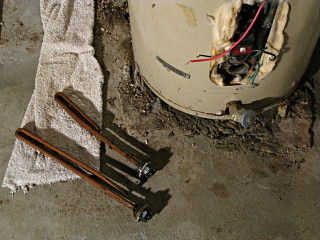
| Both elements out. Also visible is the drain tap and some of the rather uneven concrete pad area underneath. |
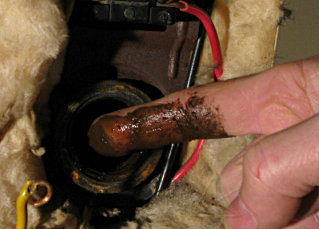
| A quick swab around the inside of the hole with a finger returned this. Blech! The water coming out of this thing was supposedly *potable*?! |
|
So the old unit was pretty clearly toast. Looking at the field of available
replacements was depressing -- tank warranties of only 5, 7, maybe 10 years.
Standards have evidently lowered severely in recent times, with new units
really expected to last less than a decade. That's ridiculous. The last
thing I was about to do was throw a short-lived "slumlord special" from the
Orange Box at the problem and only have it come back far too soon; I wanted
to see if I could find something better.
Someone on the mailing list mentioned the Rheem "Marathon" heater, and while digging around I ran across several references myself anyway. In stark contrast to everything else, these carry a *lifetime* guarantee on the tank for the originally-purchasing homeowner. The difference is a plastic tank which can't corrode -- seems like no-brainer technology, given the number of plastic tanks used in all kinds of other applications including containment of nasty chemicals. But no other manufacturers [including Rheem's own regular product line] seemed to offer something like this. About three seconds of math showed that even with the higher initial cost of such a unit, it would be more longterm cost-effective than doing the periodic replacement dance, so I decided that's what I was after. Next question was where to get one. The Big Box stores were hopeless, and most of the plumbers I was calling had never even heard of it. I did finally find a local contractor who dealt with them, but their lead time for ordering one was over a week. A couple of others pooh-poohed the idea, trying to tell me "aah, nobody buys those things". Which is complete bullshit -- these heaters are evidently really big in the midwest, and Rheem is only just starting to push them toward the northeast market. Anyway, the plumbing outfit that could get them quoted me $1300 for the whole deal, installed. For a $650 price on a 40-gallon unit, they were clearly out to make a huge profit on a couple of simple connections -- and that didn't include the electrician they claimed that I would need too. Bah. That made me think a little harder about just doing the installation myself, including the pipefitting. I understand soldering and can work on electronics and wiring just fine, and had even played around with sweating up some sample copper pipe joints a while back just to try it out -- but not on any live water-carrying lines. I even already had the requisite torches, tubing cutters, lead-free solder and flux, etc from that previous but not well-pursued impulse to finally sit down and learn how to do this stuff. Still, I didn't trust myself to be able to do it properly and then have it remain leakproof under utility water pressure. Meanwhile, a reference on Marathon's own "where to buy" webpage pointed at a somewhat peculiar place covering Massachusetts: Princeton Municipal Light. A regional power company out in the boonies. But it made sense -- these heaters are not only durable, they're super-insulated and very efficient, and power companies often rise above the profit motive and try to encourage customers to buy efficient appliances or at least wrap blankies around their old water heaters. So *they* had an assortment of Marathons IN STOCK in their back garage and even though I'm not one of their customers were perfectly willing to sell me one. I checked the dimensions on the target unit and realized that it would fit just fine in the Prius. I called the profiteering plumbers back and told them about this, asking if I delivered the heater from this alternate source could they still install it? After some "talk to the boss" hemming and hawing they said yes, so I told them I'd go ahead and get the unit and then call when the work needed done. I already had a sneaking suspicion that I was never going to call them again. |
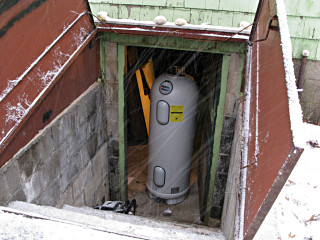
| Wrestling the thing into the basement solo was sort of interesting, if only from a balance standpoint. |

| All this research was gradually increasing my confidence about what needed to be done to install this thing, and around this point I decided that dammit, I was going to at least *attempt* the installation myself and call the pros if I got into trouble. Like the Lowes Hardware DIY webpage says, "no reason not to". It was high time I quit being such a wuss about it -- two lousy connections, and I should just dig in and learn already. As noted I had most of the tools, and I'd just need a few more fittings to interface all this to the house. |
As I wrote to a friend a little later on that otherwise fine Sunday afternoon:
well, you're absolutely *NOT* going to believe this. Everything was going along fine ... got the old tank out of the way, the new piping done, including a new ball valve for the cold- side shutoff which was a slightly more ambitious way to go at the plumbing ... all soldered up, leak-checked okay, the floor site cleaned up and reworked with some bricks and shims, and the tank into place ... and then I just *happened* to pull off the top thermostat cover for a quick looksee, and guess what's *not* actually there? The top element. There's a huge HOLE in the side of the tank where it would have gone in, and two non-connected wires nearby. I wanted to fucking cry. Naturally nobody's home at said small-town power company on Sunday, so it looks like I ride out again early tomorrow to have them rectify this situation. Hopefully I can still bring the cold back online and at least have *water*, and in theory the new ball-valve will hold it from going into the water heater better than the corroded old thing I replaced. Good thing I checked, huh? I'm going to have some lunch, go do the electrics, and then sit around and sulk.Obviously, if I had gone ahead and tried to fill the tank, bad things would have happened when the water reached this level. So I was stuck, and back to cold-water-only configuration. I did run some water into the tank anyway and about half-filled it, just to get some weight onto the bricks and make sure everything was sitting level and so I could run some water out the drain valve and flush out any cruft that might already be at the bottom. When the Princeton Light folks finally found out about this, they were falling all over themselves apologetic and as near as they could figure, someone had "temporarily" pulled an element from one of the tanks in their stock to do a quick repair for a customer and had failed to order a replacement, after which I happened to get that violated unit. A mostly honest mistake, although it's incredibly lame that someone took the time to put all the covers carefully back on as though nothing had happened and didn't bother to LABEL the heater as incomplete in a rather hazardous fashion. How long does it take to slap on a piece of white tape and write "no element" on it?? They agreed that they really needed to keep a stock of spare elements, to replace this one and to avoid continuing to move a floating "hole" around between tanks. |
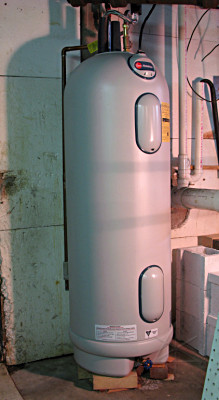
|
Done. A while later I had a nice warm *SHOWER* in my own bathroom, as opposed to relying on the kindness of friends. My, how we take modern conveniences for granted. |
.-. .-.
.-' / _____ \ `-.
`-. \ .-~~ ~~-. / .-'
\ \ / \ / /
\ / \ /
\| .--. .--. |/
| )/ | | \( |
|/ \__/ \__/ \|
/ /^\ \
\__ `-' __/
|\ /|
|\`"IIIII"'/|
\ `"""""""' /
`-._____.-'
/ / \ \
/ / \ \
.-' ( ) `-.
`-'._) (_.'-'
About a day and a half later, I began to think the new tank was posessed.
It was *breathing*. Iiiiinn, ooooouuut. A subtle clicking over in the
direction of the water meter in the basement alerted me to this, as well
occasional bouts of the same pressure-related creaking. Examining the water
meter showed the little spinning leak-detector, that moves whenever water
flows even a little bit, turning forward and then backward over about a
ten-second cycle -- sometimes just a turn or two, sometimes many. On the
backward half, when my house system was evidently feeding back into the
utility briefly, the meter would click a little louder than on the forward
half.
It was downright creepy. Tune in to part 2: Taking the Pressure Off for the solution to this little mystery! |